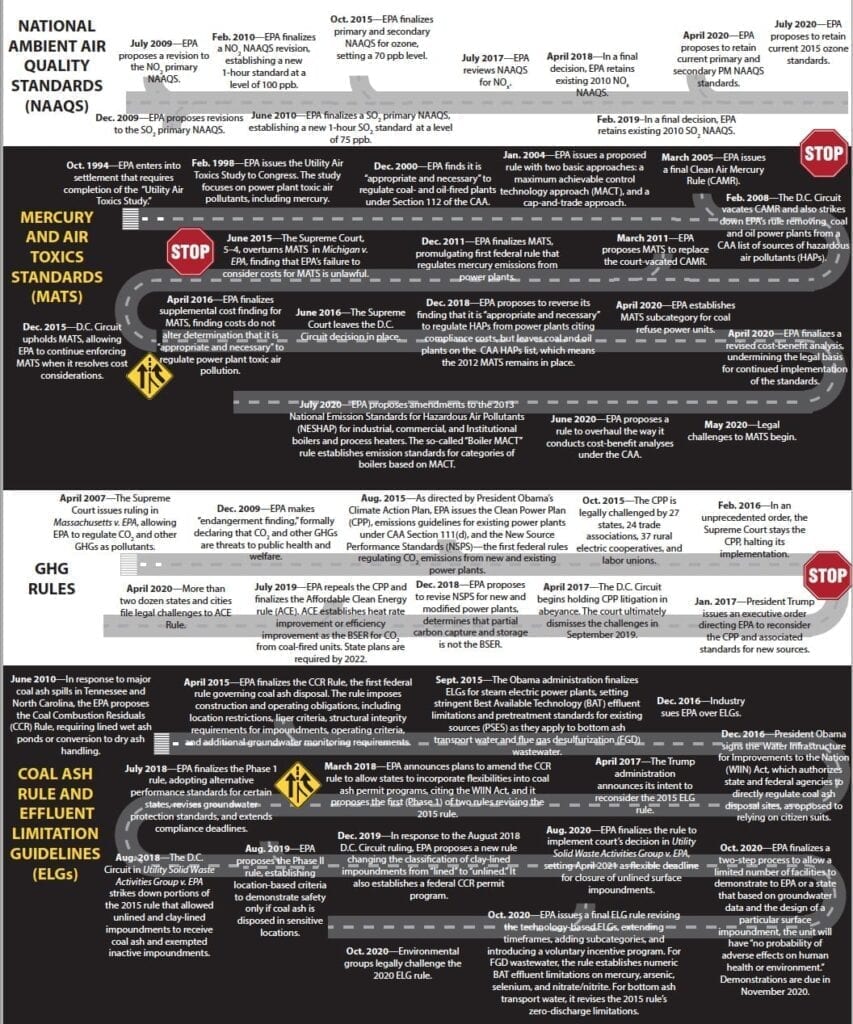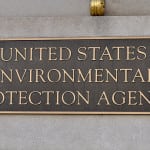Over its 50-year history, several rules issued by the U.S. Environmental Protection Agency (EPA) have reshaped the power sector. But for at least a few modern rules, the road has been full of turns.
Notes: CAA = Clean Air Act; BSER = best system of emission reduction; CO2 = carbon dioxide; GHG = greenhouse gases; FIP = federal implementation plan; PM = particulate matter; ppb = parts per billion; NO2 = nitrogen dioxide; NOx = nitrogen oxides; SO2 = sulfur dioxide.

National Ambient Air Quality Standards (NAAQS)
July 2009—EPA proposes revision to NO2 primary NAAQS.
December 2009—EPA proposes revisions to SO2 primary NAAQS.
Feb. 2010—EPA finalizes NO2 NAAQS revision; establishes a new 1-hour standard at a level of 100 ppb.
June 2010—EPA finalizes SO2 primary NAAQS; establishes a new 1-hour SO2 standard at a level of 75 ppb.
October 2015—EPA finalizes primary and secondary NAAQS for ozone to 70 ppb.
Jan. 2013—EPA proposes to revise annual PM2.5 standard by lowering the level to 12.0 micrograms per cubic meter (μg/m3).
July 2017—EPA reviews NAAQS for NOx.
April 2018—In a final decision, the EPA retains existing 2010 NOx NAAQS.
Feb. 2019–In a final decision, the EPA retains existing 2010 SO2 NAAQS.
April 2020—The EPA proposes to retain current primary and secondary PM NAAQS standards.
July 2020—The EPA proposes to retain current 2015 ozone standards.
Cross-State Air Pollution Rule (CSAPR)
July 2011—EPA finalizes CSAPR, limiting interstate transport of NOx, SO2, and PM2.5 and ozone in downwind states.
January 2015—CSAPR emissions trading program begins.
Sept. 2016—The EPA finalizes an update to the CSAPR for the 2008 NAAQS.
Sept. 2019—The EPA D.C. Circuit remands the CSAPR update to the EPA.
Oct. 2020—The EPA proposes new or amended FIPs to revise CSAPR emission budgets in 12 states.
Mercury and Air Toxics Standards (MATS)
Oct. 1994—EPA enters into a settlement to complete “Utility Air Toxics Study.”
Feb. 1998—EPA issues the Utility Air Toxics Study to Congress, focusing on power plant toxic air pollutants, including mercury.
Dec. 2000—EPA finds it is “appropriate and necessary” to regulate coal- and oil-fired plants under Section 112 of the CAA.
Jan. 2004—EPA issues a proposed rule with two basic approaches, a maximum achievable control technology approach (MACT), and a cap-and-trade approach.
March 2005—EPA issues a final Clean Air Mercury Rule (CAMR).
Feb. 2008—The D.C. Circuit vacates CAMR and also strikes down EPA’s rule removing coal and oil power plants from a CAA list of sources of hazardous air pollutants (HAPS).
March 2011—EPA proposes MATS rule to replace the court-vacated CAMR.
Dec. 2011—EPA finalizes MATS.
June 2015—The Supreme Court overturns MATS by a vote of 5–4. Justice Scalia finds the EPA’s failure to consider costs of the rule unlawful.
June 2016—The Supreme Court leaves D.C. Circuit’s decision to leave rule in place but requires EPA to conduct a supplemental cost finding.
April 2016—EPA finalizes supplemental cost finding for MATS, finding costs do not alter determination that it is “appropriate and necessary” to regulate power plant toxic air pollution.
Dec. 2018—EPA reverses finding that it is “appropriate and necessary” to regulate hazardous air pollutant emissions (HAP) from power plants, citing compliance costs, but leaves coal and oil plants on the HAPS list, which means the 2012-finalized MATS remains in place.
April 2020—EPA establishes MATS subcategory for coal refuse power units.
May 2020—EPA finalizes reversed supplemental cost finding and risk technology review.
May 2020—Legal challenges to MATS begin.
July 2020—EPA proposes amendments to the 2013 National Emission Standards for Hazardous Air Pollutants (NESHAP) for industrial, commercial, and Institutional boilers and process heaters. The so-called “Boiler MACT” rule establishes emission standards for categories of boilers based on MACT.
Affordable Clean Energy (ACE) Rule
April 2007—Supreme Court issues ruling in Massachusetts v. EPA, allows EPA to regulate CO2 and other greenhouse gases (GHGs) as pollutants.
Dec. 2009—EPA makes “endangerment finding,” formally declares CO2 and other GHGs are threats to public health and welfare.
August 2015—As directed by President Obama’s Climate Action Plan, EPA issues the Clean Power Plan (CPP) emissions guidelines for existing power plants under the CAA Section 111(d), and the New Source Performance Standards (NSPS), the first federal rules regulating CO2 emissions from new and existing power plants.
Oct. 2015—The CPP is legally challenged by 27 states, 24 trade associations, 37 rural electric cooperatives, and labor unions.
Feb. 2016—Supreme Court stays the CPP, halting its implementation.
Jan. 2017—President Trump issues executive order directing EPA to reconsider the CPP and associated standards for new sources.
April 2017—D.C. Circuit begins holding litigation in abeyance. The court dismisses the challenges in September 2019.
Dec. 2018—EPA proposes to revise NSPS for new and modified power plants, determines that partial carbon capture and storage is not the BSER.
July 2019—EPA repeals the CPP and finalizes the Affordable Clean Energy rule (ACE). ACE establishes heat rate improvement or efficiency improvement as the BSER for CO2 from coal-fired units. State plans are required by 2022.
April 2020—More than two dozen states and cities file legal challenges to the ACE Rule.
Coal Combustion Residual (CCR) Rule
June 2010—Following the 2008 Kingston coal ash spill, EPA proposes a CCR rule, requiring lined wet ash ponds or conversion to dry ash handling.
April 2015—EPA finalizes first federal rule governing coal ash disposal. The rule imposes construction and operating obligations, including location restrictions, liner criteria, structural integrity requirements for impoundments, operating criteria and additional groundwater monitoring requirements.
July 2018—EPA issues rule that modifies certain compliance deadlines. Rule is challenged in court in December 2018, promoting EPA to file a motion for a partial remand of the July 2018 rule.
August 2018—The D.C. Circuit strikes down provisions of the 2015 rule that allows unlined and clay-lined impoundment to receive coal ash and exempted inactive impoundment.
Dec. 2019—EPA proposes a federal permit program implementing the Water Infrastructure Improvements for the Nation Act that would apply in states that do not have an approved CCR program.
Aug. 2020—EPA finalizes rule to implement the court’s decision, setting April 2021 as flexible deadline for closure of unlined surface impoundments.
Nov. 2020—EPA finalizes a rule allowing facilities to request an alternate liner for CCR surface impoundments. The final rule alters EPA’s definition of “unlined” CCR surface impoundments and establishes a two-step process for submission of the necessary documentation for the alternate liner demonstration.
Effluent Limitation Guidelines (ELG)
Nov. 2015—The Obama administration finalizes ELGs for steam electric power plants, setting stringent Best Available Technology (BAT) effluent limitations and pretreatment standards for existing sources (PSES) as they apply to bottom ash transport water and flue gas desulfurization (FGD) wastewater.
Dec. 2016—Industry sues EPA over the rule.
April 2017—Trump administration announces its intent to reconsider 2015 rule.
Nov. 2017—EPA issues final rule postponing compliance deadlines for the BAT effluent limitations and PSES for bottom ash transport water and FGD wastewater.
Oct. 2020—EPA issues a final rule revising the technology-based ELGs, extending timeframes, adding subcategories, and introducing a voluntary incentive program. For FGD wastewater, the rule establishes numeric BAT effluent limitations on mercury, arsenic, selenium, and nitrate/nitrite. For bottom ash transport water, it revises the 2015 rule’s zero-discharge limitations.
Oct. 2020—Environmental groups legally challenge 2020 ELG rule.
Waters of the U.S. (WOTUS) Rule
June 2015–The Obama administration issues a rule defining the scope of waters protected under the Clean Water Act (CWA) in light of “the statute, science, Supreme Court decisions in U.S. v. Riverside Bayview Homes, Solid Waste Agency of Northern Cook County v. U.S. Army Corps of Engineers (SWANCC), and Rapanos v. United States (Rapanos), and the agencies’ experience and technical expertise.”
July 2015–Thirteen states sue EPA and the Army Corps of Engineers, which they say illegally puts the federal government in charge of a majority of water and land resources in the Electric utilities express concerns that water near power plants, such as water drainage ditches and cooling ponds, may be considered U.S. waters.
Aug. 2015—The U.S. District Court for North Dakota issues a preliminary injunction, blocking the rule hours before it was set to take effect.
Oct. 2015—The Sixth Circuit issues a nationwide stay, blocking implementation of the rule.
Feb. 2017—President Trump issues Executive Order 13778, directing the EPA and Army Corps of Engineers to “review and potentially revise” the WOTUS rule.
Jan. 2018—The Supreme Court issues a unanimous ruling that lawsuits to challenge the WOTUS rule must be filed in federal district courts rather than federal courts of appeals, voiding the Sixth Circuit’s claim of jurisdiction, and throwing into doubt the future of the rule’s nationwide stay.
Feb. 2018—EPA and the Army Corps of Engineers issue a final rule, extending the applicability date of the WOTUS rule to February 6, 2020. The rule is one of two steps aiming to repeal the WOTUS rule.
Dec. 2018—In a move widely applauded by the power industry, EPA and the Army Corps propose a new definition of “waters of the U.S.” that could exempt groundwater and ditches from regulation under the CWA.
Sept. 2019—EPA finalizes the repeal of the 2015 WOTUS rule, rolling back the expanded definition of “WOTUS” proposed under the Obama administration.
April 2020—EPA and Army Corps publish a final rule, the “Navigable Waters Protection Rule,” to replace the Sept. 2019 rule. The rule, which became effective in June 2020, outlines six categories of what would be considered “waters of the U.S.”: traditional navigable waters; tributaries; certain ditches; certain lakes and ponds; impoundments; and adjacent wetlands. It also outlines what would not be considered WOTUS, a list that includes groundwater.
—Sonal Patel is POWER’s senior associate editor.










